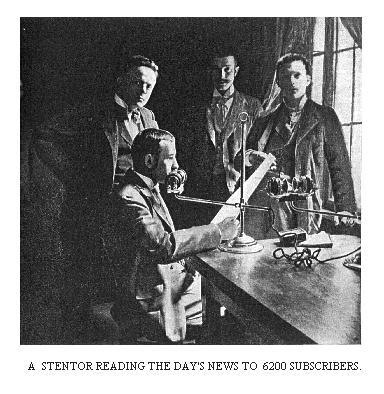World's Work, April, 1901, pages 640-643:
THE "TELEFON-HIRMONDO," OR "NEWSTELLER," OF BUDAPEST--THE DAY'S NEWS TOLD AS IT OCCURS TO 6200 SUBSCRIBERS IN THEIR HOMES--A REGULAR PROGRAMME LASTING FROM 10.30 A.M. TO 10.30 P.M.--SUNDAY-NIGHT CONCERTS TRANSMITTED TO THE SUBSCRIBERS--A MOST SUCCESSFUL INNOVATION |
BY
THOMAS S. DENISON

wE are very apt to claim preëminence for America in the matter of inventions and of novel mechanical applications. But the Hungarians have had for eight years in actual working operation a development of the telephone of which few people in the United States know anything, even by report: the telephone newspaper, or Telefon-Hirmondo as it is called, of Budapest.
For a quarter of a century one of the favorite dreams of the modern prophets has pictured the home equipped with apparatus by means of which one can hear concerts or listen to the latest news, while sitting comfortably by his own fireside. This dream is a fact to-day in Budapest. Music, telegraphic news "hot" from the wires, literary criticism, stock quotations, reports of the Reichsrath, -- the whole flood of matter that fills the columns of our newspapers may be had for the mere lifting of a telephone receiver.
I went to Budapest last May, expecting to find this unique "newspaper," of which I had heard so much, rather a fad for a few score of people who had sufficient interest to keep it as a passing diversion. To my surprise I found a great journal with all the equipments of a first-class paper in a very lively city of nearly 600,000 people -- all the equipment, that is, except presses, paper, and printer's ink. Telefon Hirmondo has 6200 subscribers. The staff consists of a business manager, an editor-in-chief, four assistant editors, and nine reporters.
This novel and interesting enterprise was started about eight years ago by Theodore Buschgasch, who had been interested in electricity and had patented some inventions. Mr. Buschgasch died March 16, 1893, and the present efficiency of the paper in all that pertains to its technique is largely due to Mr. Emil von Szveties, who is known on the staff as technical director. His skill and energy have produced great results. The concern is owned by a stock company with a capital of 600,000 florins (about $250,000).
Telefon-Hirmondo occupies commodious offices on the third and fourth floors of a fine building on one of the finest avenues of Budapest. It divides the entire city into twenty-seven districts, and the main wire runs to each district, with branch wires to the houses. An accurate map of the system hangs in the central office. The company owns its own wires and plant throughout, and has the same right to place wires that is enjoyed by the telephone and telegraph companies.
[excerpt]
http://earlyradiohistory.us/telenew1.htm


